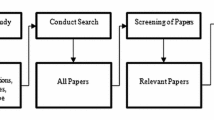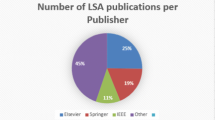Abstract
One important goal of black-box complexity theory is the development of complexity models allowing to derive meaningful lower bounds for whole classes of randomized search heuristics. Complementing classical runtime analysis, black-box models help us to understand how algorithmic choices such as the population size, the variation operators, or the selection rules influence the optimization time. One example for such a result is the \(\varOmega (n \log n)\) lower bound for unary unbiased algorithms on functions with a unique global optimum (Lehre and Witt in Algorithmica 64:623–642, 2012), which tells us that higher arity operators or biased sampling strategies are needed when trying to beat this bound. In lack of analyzing techniques, such non-trivial lower bounds are very rare in the existing literature on black-box optimization and therefore remain to be one of the main challenges in black-box complexity theory. With this paper we contribute to our technical toolbox for lower bound computations by proposing a new type of information-theoretic argument. We regard the permutation- and bit-invariant version of LeadingOnes and prove that its \((1+1)\) elitist black-box complexity is \(\varOmega (n^2)\), a bound that is matched by \((1+1)\)-type evolutionary algorithms. The \((1+1)\) elitist complexity of LeadingOnes is thus considerably larger than its unrestricted one, which is known to be of order \(n\log \log n\) (Afshani et al. in Lecture notes in computer science, vol 8066, pp 1–11. Springer, New York, 2013). The \(\varOmega (n^2)\) lower bound does not rely on the fact that elitist black-box algorithms are not allowed to make use of absolute fitness values. In contrast, we show that even if absolute fitness values are revealed to the otherwise elitist algorithm, it cannot significantly profit from this additional information. Our result thus shows that for LeadingOnes the memory-restriction, together with the selection requirement, has a substantial impact on the best possible performance.
Similar content being viewed by others
Notes
We remark without proof that the same argument also works in a different model of computation where the algorithm is allowed to generate random real number in the interval [0, 1].
For every i we fix \(n_i\) arbitrarily for which the statement holds when \(p=c=1/i\). Without loss of generality, we may assume that the \(n_i\) are growing (by assumption, for every i there are arbitrary large values for n for which some algorithm A spends at least time cn with probability at most p). Then we maychoose the functions \(p(n), c(n) = o(1)\) so slowly decreasing that \(p(n_i),c(n_i) \ge 1/i\). For these functions p(n), c(n), there are still arbitrarily large n for which the statement holds, since it holds for all triples \((n_i, p(n_i), c(n_i))\).
References
Afshani, P., Agrawal, M., Doerr, B., Doerr, C., Larsen, K.G., Mehlhorn, K.: The query complexity of finding a hidden permutation. Space-Efficient Data Structures, Streams, and Algorithms-Papers in Honor of J. Ian Munro on the Occasion of His 66th Birthday. Lecture Notes in Computer Science, vol. 8066, pp. 1–11. Springer, New York (2013)
Böttcher, S., Doerr, B., Neumann, F.: Optimal fixed and adaptive mutation rates for the LeadingOnes problem. In: Proceedings of the 11th International Conference on Parallel Problem Solving from Nature (PPSN’10), pp. 1–10. Springer (2010)
Doerr, B., Doerr, C., Ebel, F.: Lessons from the black-box: Fast crossover-based genetic algorithms. In: Proceedings of Genetic and Evolutionary Computation Conference (GECCO’13), pp. 781–788. ACM (2013)
Doerr, B., Johannsen, D., Kötzing, T., Lehre, P.K., Wagner, M., Winzen, C.: Faster black-box algorithms through higher arity operators. In: Proceedings of Foundations of Genetic Algorithms (FOGA’11), pp. 163–172. ACM (2011)
Doerr, B., Winzen, C.: Black-box complexity: breaking the \(O(n \log n)\) barrier of LeadingOnes. Artificial Evolution (EA’11), Revised Selected Papers. Lecture Notes in Computer Science, vol. 7401, pp. 205–216. Springer, New York (2012)
Doerr, B., Winzen, C.: Playing mastermind with constant-size memory. Theory Comput. Syst. 55, 658–684 (2014)
Doerr, B., Winzen, C.: Ranking-based black-box complexity. Algorithmica 68, 571–609 (2014)
Doerr, C., Lengler, J.: Elitist black-box models: analyzing the impact of elitist selection on the performance of evolutionary algorithms. In: Proceedings of Genetic and Evolutionary Computation Conference (GECCO’15), pp. 839–846. ACM (2015)
Doerr, C., Lengler, J.: OneMax in black-box models with several restrictions. In: Proceedings of Genetic and Evolutionary Computation Conference (GECCO’15), pp. 1431–1438. ACM (2015)
Doerr, C., Lengler, J.: The \((1+1)\) elitist black-box complexity of LeadingOnes. In: Proceedings of Genetic and Evolutionary Computation Conference (GECCO’16), pp. 1131–1138. ACM (2016)
Droste, S., Jansen, T., Wegener, I.: On the analysis of the \((1+1)\) evolutionary algorithm. Theor. Comput. Sci. 276, 51–81 (2002)
Droste, S., Jansen, T., Wegener, I.: Upper and lower bounds for randomized search heuristics in black-box optimization. Theory Comput. Syst. 39, 525–544 (2006)
Ladret, V.: Asymptotic hitting time for a simple evolutionary model of protein folding. J. Appl. Prob. 42, 39–51 (2005)
Lehre, P.K., Witt, C.: Black-box search by unbiased variation. Algorithmica 64, 623–642 (2012)
Motwani, R., Raghavan, P.: Randomized Algorithms. Cambridge University Press, Cambridge (1995)
Mühlenbein, H.: How genetic algorithms really work: mutation and hillclimbing. In: Proceedings of the 2nd International Conference on Parallel Problem Solving from Nature (PPSN’92), pp. 15–26. Elsevier (1992)
Rudolph, G.: Convergence Properties of Evolutionary Algorithms. Verlag Dr. Kovač, Hamburg (1997)
Sudholt, D.: A new method for lower bounds on the running time of evolutionary algorithms. IEEE Trans. Evol. Comput. 17, 418–435 (2013)
Yao, A.C.C.: Probabilistic computations: toward a unified measure of complexity. In: Proceedings of Foundations of Computer Science (FOCS’77), pp. 222–227. IEEE (1977)
Acknowledgements
This research benefited from the support of the “FMJH Program Gaspard Monge in optimization and operation research”, and from the support to this program from EDF (Électricité de France).
Author information
Authors and Affiliations
Corresponding author
Rights and permissions
About this article
Cite this article
Doerr, C., Lengler, J. The \((1+1)\) Elitist Black-Box Complexity of LeadingOnes. Algorithmica 80, 1579–1603 (2018). https://doi.org/10.1007/s00453-017-0304-6
Received:
Accepted:
Published:
Issue Date:
DOI: https://doi.org/10.1007/s00453-017-0304-6




